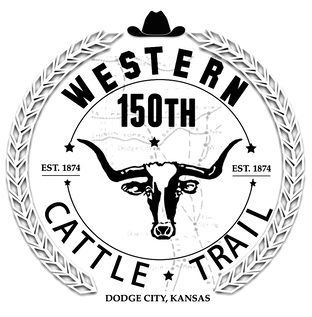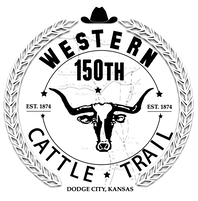NOW OPEN - Western Cattle Trail Association 150th Conference Registration
Limited seats available. First Come, First Serve. Click here to register now!
Western Cattle Trail Association Website
|
The purpose of the Western Cattle Trail Association Website is to share with others the fascinating history of cattle driving from Texas to points north that helped build America. This short-lived endeavor of cow outfits driving herds of longhorns to a market or range, stopping along the way near cattle towns and road ranches, encompasses the Old West in its purest form. The American cowboy icon was born and recognized worldwide in this brief fifty-year span.
|
|
The task of pushing Texas cattle to a northern destination ended in 1897, the heritage of that one industry continues to be retold again and again through movies, reenactments, novels, and nonfictional journals and magazines. Thus, our purpose here is to join together at all points along the trail in an association to tell the many stories gathered throughout history by all who knew before us and by all who have a story to tell after us about the Western Cattle Trail. Based on transcripts from Gary & Margaret Kraisinger
History of the Western Cattle Trail
|
Directly northwest of May, Oklahoma, the route crossed the Beaver River (North Canadian River), fording on the sand bar at the mouth of Clear Creek. It then passed near present Laverne and Rosston; it crossed the border into Kansas just east of the Cimarron River and then crossed that stream at Deep Hole Crossing.
Here the drovers could visit the Long Horn Round-Up Saloon or the Dead Fall Saloon. Finally, the trail veered slightly eastward from the Cimarron to cross the Arkansas River at Dodge City. The final section followed the Arkansas River westward to the stock pens at the railhead on the Atchison, Topeka, and Santa Fe Railway. During the 1880s, the drives frequently passed by Dodge City, heading to Ogallala, Nebraska, and Wyoming. In addition, some herds traveled to Canada. However, most of the more than two million longhorns that traveled up the Western Trail were shipped out of Dodge City. The route remained busy until 1891, when traffic fell drastically. In 1894 John Blocker drove his herd from West Texas to South Dakota on the Western Trail, its last recorded use. |
By 1886 the overland cattle trade was entering its final phase. The railroads were building their lines down into Texas, and driving cattle the long distances to market was no longer necessary. However, some cattlemen continued the drives until about 1891 because driving cattle to the market was cheaper than shipping them by rail.
Another reason for discontinuing the drives was the opposition of the northern cattlemen and farmers. They felt that the cattle from the South were competing with their markets. They also claimed that the Texas cattle were carriers of a Texas fever disease, and they did not want their cattle infected. As a result, many states passed quarantine laws against Texas cattle. The homesteaders living near the cattle trails complained, also that the cattle destroyed their crops and tore down their fences. By the turn of the twentieth century, the cattle driving industry was no more.
Another reason for discontinuing the drives was the opposition of the northern cattlemen and farmers. They felt that the cattle from the South were competing with their markets. They also claimed that the Texas cattle were carriers of a Texas fever disease, and they did not want their cattle infected. As a result, many states passed quarantine laws against Texas cattle. The homesteaders living near the cattle trails complained, also that the cattle destroyed their crops and tore down their fences. By the turn of the twentieth century, the cattle driving industry was no more.
In a published book, "Some Southwestern Trails," Jack Potter tells this story:
"Of the three great trails along which longhorn cattle were pointed out of Texas, to markets a thousand miles away, the Western Trail came into existence. The shifting settlements of Texas and Kansas were pushing the drivers west; Indians were being pushed back east to reservations in present Oklahoma; and ranchmen in need of herds were taking the ranges that they had, and the buffalo had left. But everybody was in need of money, our ranges were covered with cattleand we were hell-bent on driving them.
"The Western Trail, sometimes called the Fort Griffin and Dodge City Trail, because its herds touched at those two points on the frontier of Texas and Kansas, was laid out in 1876. The earlier Texas trail that merged with the Chisholm trail in Oklahoma, was giving too much trouble to the nesters along its course. Cowmen in South Texas came up by way of San Antonio and out through the hill country, where we were ranging, prospecting a course and figuring on the right of way. They got it.
"In the seventies we were driving tens of thousands of longhorn cattle up this trail from the great breeding grounds of Texas. With a crew of cowboys, a cook, and a horse wrangler, to handle our remuda, we poked along some ten to twelve miles a day, with thousands of longhorns always headed, every step of the way, straight toward the shipping pens of Dodge City, notorious Cowboy Capital of the World.
"We forgot our worries in the rip-snorting village of Fort Griffin and refilled our chuck wagon with frijoles, bacon, and dried fruit at Doan's crossing, on the Red River. We bargained for peace with the Comanche Indians as we crossed Indian Territory with a generous gift of our bosses' beeves. We swam the Canadian River in flood, crossed the hot dry sands of the Cimarron, and washed our woes away when we bellied up to the bars in Dodge. From there we drove herds that stocked the west all the way from the Black Hills of the Dakotas to the head waters of the Missouri. We settled half a world without knowing it, and we had a barrel of fun.
"But the settlers and barbed wire caught us. They closed Kansas by rigid quarantine to these wild longhorns and the wilder boys who drove them. Already in the late 80's we could tell that the country was getting crowded. And so we packed our beds, and cut our mounts, and drifted farther west to other jobs on a fresher range where at least we still had room to bend our elbows and blow about the wonders of the Western Trail."
Reference: Articles by Heinie Schmidt: Ashes of My Campfire; Article by Tom Stauth Kansas and Kansans, Vol. 5, page 2107; Connelley, Dodge City Globe; The Rath Trail, Ida Ellen Rath; Letters from Jack Potter to Author.
"The Western Trail, sometimes called the Fort Griffin and Dodge City Trail, because its herds touched at those two points on the frontier of Texas and Kansas, was laid out in 1876. The earlier Texas trail that merged with the Chisholm trail in Oklahoma, was giving too much trouble to the nesters along its course. Cowmen in South Texas came up by way of San Antonio and out through the hill country, where we were ranging, prospecting a course and figuring on the right of way. They got it.
"In the seventies we were driving tens of thousands of longhorn cattle up this trail from the great breeding grounds of Texas. With a crew of cowboys, a cook, and a horse wrangler, to handle our remuda, we poked along some ten to twelve miles a day, with thousands of longhorns always headed, every step of the way, straight toward the shipping pens of Dodge City, notorious Cowboy Capital of the World.
"We forgot our worries in the rip-snorting village of Fort Griffin and refilled our chuck wagon with frijoles, bacon, and dried fruit at Doan's crossing, on the Red River. We bargained for peace with the Comanche Indians as we crossed Indian Territory with a generous gift of our bosses' beeves. We swam the Canadian River in flood, crossed the hot dry sands of the Cimarron, and washed our woes away when we bellied up to the bars in Dodge. From there we drove herds that stocked the west all the way from the Black Hills of the Dakotas to the head waters of the Missouri. We settled half a world without knowing it, and we had a barrel of fun.
"But the settlers and barbed wire caught us. They closed Kansas by rigid quarantine to these wild longhorns and the wilder boys who drove them. Already in the late 80's we could tell that the country was getting crowded. And so we packed our beds, and cut our mounts, and drifted farther west to other jobs on a fresher range where at least we still had room to bend our elbows and blow about the wonders of the Western Trail."
Reference: Articles by Heinie Schmidt: Ashes of My Campfire; Article by Tom Stauth Kansas and Kansans, Vol. 5, page 2107; Connelley, Dodge City Globe; The Rath Trail, Ida Ellen Rath; Letters from Jack Potter to Author.






